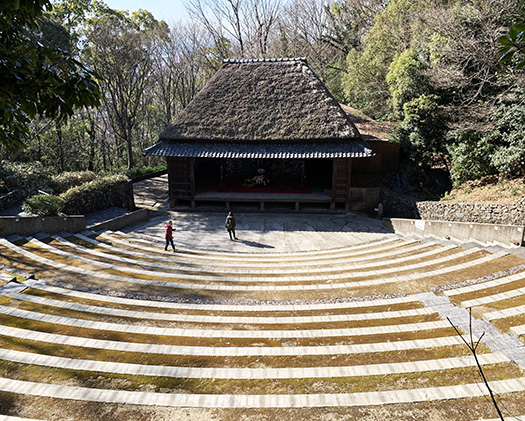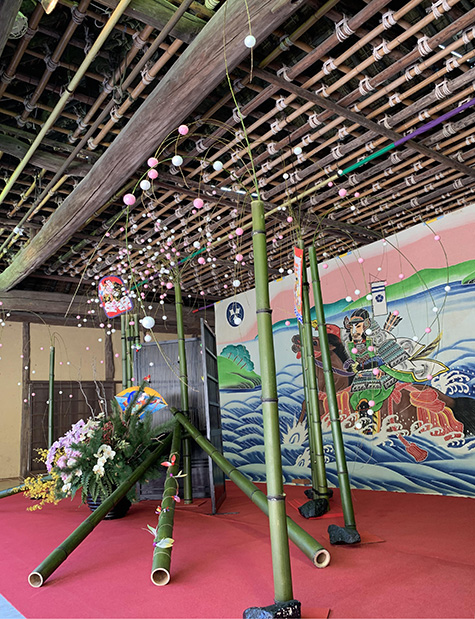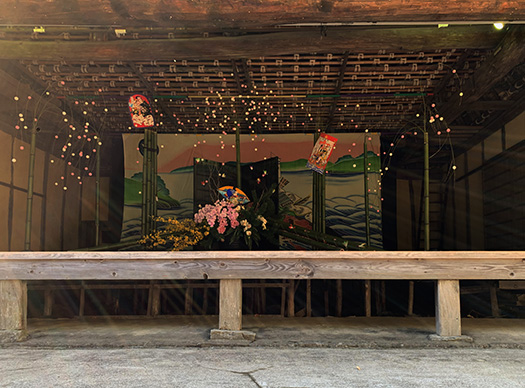

さて札幌の大雪ドカ雪での都市機能クライシスでありますが、
昨日は朝からマヒ状態の都市機能ぶりを散歩で確認した後、
昼間には久しぶりに友人と会食で外出。
「JRなにやっているんだ」という意見が飛び交っているのですが、
一昨年の地震からの大停電の記憶でもなかなかにしたたかだった地元民。
停電で冷蔵庫がダメになったら庭先や海辺などに繰り出して
冷蔵庫の冷凍食品群を平らげるためにバーベキューを楽しんで乗りきった。
困難を癒してくれる大自然があるというのはありがたかった。
JRの不通も「どもこもならん」と怒りつつ、また道路の大渋滞にも
案外、良い面を見出してしのごうとするメンタルがある。
JRからも詳細な説明資料が公開され、情報開示されている。
いちいちの情報についてはそちらをチェックしていただきたいのですが、
「なんもさ」という他者肯定力こそは北海道人の貴重で強力な心性。
気候条件のきびしさがおおらかな心性を育てているともいえる。
そういう部分が日本人のなかでいちばん発達しているとも思われるのですね。
社会の復元力に期待したいところだと思っています。
ということで緊急事態対応的なブログ記事でしたが、
本日からふたたび「日本人と住空間」という本来趣旨で続けたいと思います。
先日来、屋島の掘り起こし型ブログ記事でしたが、
この四国屋島の麓には「四国村」という民俗建築保存エリアがある。
わたしの傾向を踏まえて事前にカミさんが情報を丹念に集めてくれていたので、
たっぷり半日以上、全部の古民家・建築群を堪能させていただきました。
その様子をご覧いただきながら、四国という地域の民俗に迫って見たい。
建築痕跡、古民家群には暮らしの証言が明瞭に残っていて
北海道人の「なんもさ」心理にも通ずる普遍的な楽観主義が匂い立つ。
生き延びてきた人々のいとなみが立ち上ってくるのですね。
最初は全国各地に1000箇所以上あるという「農村歌舞伎舞台」であります。


〜この舞台は小豆島の土庄町小部(こべ)地区が所有、島の村々の氏神の秋祭りには
「地芝居」という農村歌舞伎が奉納されていた。江戸末期に構築された舞台であり、
島内でも20余りあったが現在は数少ない。屋根は寄棟造りのカヤ葺。
裏に1間半(約2.73m)の桟瓦(さんがわら)葺の下屋が4間半にわたってある。
前面はカヤ屋根を切り上げて桟瓦葺の庇としている。建物は間口6間、奥行4間半で
天井がなく木組がむき出し。廻り舞台は床下の地面を掘り中央に台石をすえ、
これに心棒がついて人力によって舞台を廻していた。舞台中央の廻り舞台は直径4.72m。
上手にチョボのユカ、お囃座(はやしざ)があり、裏の下屋は楽屋となっている。
この舞台は昭和52年(1977年)に現在の位置に移築。江戸時代の建物と証明される
「文久三亥(西暦1863年)八月御祭礼」と記した墨書がある。〜
<高松市歴史民俗協会・高松市文化財保護協会1992年『高松の文化財』より抜粋>
地域社会という結びつきを強めてくれる空間として
多くの人々の息づかいが伝わってくる。
日々の労働から離れてのいっときの「解放空間」が広がっている。
演者と客席との相互の心の交流が残響のように響き渡っているように感じる。
English version⬇
[Shodoshima Rural Kabuki Stage Shikoku Living Space Exploration-1]
By the way, it is an urban function crisis due to heavy snowfall in Sapporo.
Yesterday, after confirming the urban function of the paralyzed state from the morning on a walk,
In the daytime, I went out for dinner with my friends for the first time in a while.
There are many opinions about what JR is doing, but
The locals were quite happy with the memory of the big blackout from the earthquake two years ago.
If the refrigerator fails due to a power outage, go out to the garden or the beach
I enjoyed the barbecue to flatten the frozen foods in the refrigerator.
I was grateful that there was nature that healed the difficulties.
While getting angry at the JR outage, “I’m not a kid,” and also in heavy traffic on the road.
Unexpectedly, there is a mentality that tries to find a good side and overcome it.
Detailed explanatory materials have also been released by JR, and information has been disclosed.
I would like you to check that for each piece of information.
The affirmative power of others, “Namosa,” is the precious and powerful spirit of the Hokkaido people.
It can be said that the harshness of the climatic conditions fosters a laid back spirit.
It seems that such a part is the most developed among Japanese people.
I would like to expect the restoring force of society.
So it was an emergency response blog article,
From today, I would like to continue with the original purpose of “Japanese and living space”.
The other day, it was a blog post about Yashima’s digging up.
At the foot of this Shikoku Yashima, there is a folk building preservation area called “Shikoku Village”.
Mr. Kami carefully gathered information in advance based on my tendency, so
I thoroughly enjoyed all the old folk houses and buildings for more than half a day.
While watching the situation, I would like to take a closer look at the folklore of the region of Shikoku.
The testimony of living is clearly left in the traces of architecture and the old folk houses.
A universal optimism that is similar to the “nothing” psychology of Hokkaido people is scented.
The friends of those who have survived will rise up.
The first is the “Rural Kabuki Stage,” which has more than 1,000 locations throughout Japan.
~ This stage is owned by the Kobe district of Tonosho Town on Shodoshima, and is used for the autumn festival of Ujigami in the villages of the island.
A rural Kabuki called “Ji-drama” was dedicated. It is a stage built in the late Edo period,
There were more than 20 on the island, but there are few now. The roof is a hipped roof.
There is a one-and-a-half (about 2.73 meters) thatched-roof house on the back for four and a half ken.
The front is rounded up from the Kaya roof to form a tiled roof. The building has a frontage of 6 ken and a depth of 4 and a half.
There is no ceiling and the wooden structure is exposed. For the revolving stage, dig the ground under the floor and set a pedestal in the center.
A mandrel was attached to this, and he was turning the stage manually. The revolving stage in the center of the stage is 4.72m in diameter.
There is Chobo Yuka and Hayashiza well, and the back cottage is a dressing room.
This stage was relocated to its current position in 1977. Proved to be a building from the Edo period
There is an ink book that says “Bunkyu Sanyo (1863 AD) August Festival”. ~
As a space that strengthens the ties of the local community
The breath of many people is transmitted.
A momentary “liberation space” away from daily labor is expanding.
I feel that the mutual emotional exchange between the performer and the audience reverberates like reverberation.
Posted on 2月 9th, 2022 by 三木 奎吾
Filed under: 出張&旅先にて, 日本社会・文化研究







コメントを投稿
「※誹謗中傷や、悪意のある書き込み、営利目的などのコメントを防ぐために、投稿された全てのコメントは一時的に保留されますのでご了承ください。」
You must be logged in to post a comment.